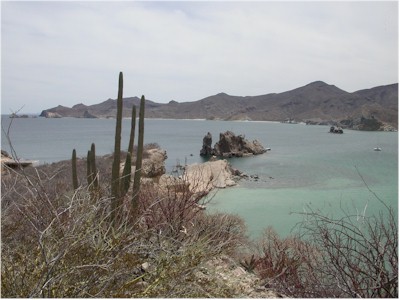
Wild San Juanico
 |
|
Wild San Juanico |
Our next port was San Juanico, back on the mainland. For the first part of our trip we had no wind at all, then about 3 miles from our anchorage we suddenly had about 20 knots from the north. We quickly put up the sails and had a great sail for about an hour as we tacked up towards San Juanico. We were glad to get inside the bay as the waves had quickly started to build and we were starting to get lots of spashes on deck.
San Juanico was another wildly rugged bay, many interesting rock islands and various formations, good hiking and lots of snorkeling. Particularly interesting on shore were the sandstone cliffs chock full of shell fossils. Also there is a cruiser shrine on a shoreside tree covered with signs and trinkets left behind from visiting boats. We found a pelican skull and beak on the beach and left it behind on the pile to mark our visit.
After a few days in San Juanico, we headed north to Bahia Concepcion, a large 20 mile long landlocked bay with a number of good anchorages. Early in the morning, we had a mellow west wind from the land and sailed with the wind on our beam for about an hour. Unfortunately, the wind slowly died to nothing and then blasted us from the north for the next few hours. We motorsailed into it -- another good test for the transmission. It finally let up as we reached Punta Santa Teresa and was light for the next 10 miles up to Punta Concepcion. We rounded the point into Bahia Concepcion, which runs north-south and were surprised to see the north wind pick up again. But THIS time we were glad to have it as we were now heading south into the bay, so put up or genoa and had a fabulous downwind run into the bay at 7 knots with about 20 knots of wind funneling into the bay. Good sailing at last! We only had about 7 miles to go, but we'll take whatever good sailing we can get down here.
|
Sailing into Santispac, Bahia Concepcion |
After setting our hook off the camping beach of Santispac, we noticed that our guidebook was right in that this was a beautiful spot, but not a solitary one. The beach was full of campers left over from Easter week and wintering RV's and there were many homes along the shore and even a few restaurants. Also, Highway 1, the main highway of Baja travels right along the beach so we could hear the rumbling of trucks and cars day and night. The bay was gorgeous though -- surrounded by tall mountains on all sides and the water the typical clear blue-green of the Sea of Cortez.
The highlight of our stay in Santispac was when we got a ride into the town of Mulegé, which lies on the Rio Santa Rosalia. Because of the fresh water, the town lies in the river valley among a tangle of luscious green palm trees, like a true oasis in the desert. It was a great little town and we had a good time exploring it on foot and sampling one of the local restaurants, El Candil. The local museum with all sorts of old artifacts is housed in the old prison above the town -- an eerie place where you can freely explore the courtyard and outdoor cells.
We stayed in our anchorage at Santispac the week we were in Concepcion as every day the wind would howl from the north. Tucked south of Santispac beach we were well protected from any waves so took the dinghy around the bay to the other anchorages instead.
|
The oasis of Mulegé |
On a number of the surrounding beaches trickle little hot springs -- these were so hot we couldn't even put our feet in! Some folks had built up little rock pools that you can sit in at medium tide when the cool salt water mixes with the boiling hot spring water, but sitting in hot water just didn't appeal to us at all in this heat. In the northwest though, we'd have dived right in.
After a week of mostly being lazy in Bahia Concepcion, we headed north again, this time to our last stop on Baja, the old French mining town of Santa Rosalia. Halfway after a few hours of motoring, we stopped to anchor for the night at Punta Chivato, a fairly unexciting anchorage with lots of big retirement homes, but it did have some great shell combing beaches.
The rest of the way to Santa Rosalia was calm as well, and we motored all the way into Santa Rosalia's breakwater and took the last slip at the tiny Marina Santa Rosalia which only holds about 12 boats. We filled out the marina paperwork with Ricardo, the marina's sole caretaker. This consisted of writing our boat name on a slip of paper. He explained that the pop and beer in the marina building were sold on a honor system. If we wanted a beer or soda, we'd just take one from the unlocked cooler and put a checkmark on our boat's slip for each one we took. The cruisers in the marina were responsible for locking the gate at night and keeping things picked up. What a friendly place!
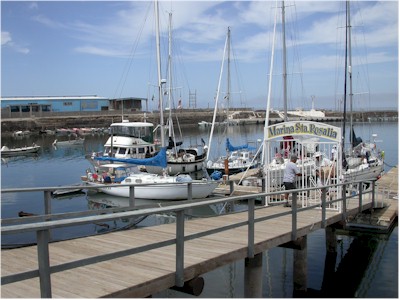 |
|
Very quaint Marina Santa Rosalia |
Santa Rosalia is one of Baja's most interesting historical towns. From a travel guide:
There are excellent reasons for the tourist to visit Santa Rosalia. The town is very quaint, with a somewhat different history than the rest of Baja. The town was originally founded in 1885 due to the discovery of copper. A French company, El Boleo, obtained the rights to the mining concession from the Mexican government for 99 years, 50 of which was tax exempt, as well as over 1 million acres of land. In exchange, they had to build a town, provide employment, and were to be responsible for the establishment of a maritime route between Santa Rosalia and Guaymas. They imported wood from France with which to build, as well as coal from Newcastle. In 1897 they also imported a rather unique church. It had been designed and built out of steel by Gustave Eiffel (yes, the Eiffel tower Eiffel) for the World Exposition of Paris in 1889. It was then sold, disassembled and shipped to Santa Rosalia where it was reassembled as the Iglesia Santa Barbara. The church is still in operation today, and is quite a beautiful sight. Despite all of this, the conditions under which the Mexican people worked were deplorable. In one year alone, over 1400 workers died. Many died of lung disease, but there was also an abundance of unexplained accidents. There were many labor strikes, all of which were put down with extreme force. El Boleo established several other mining centers, and eventually most of the copper was depleted. In 1954 the mines were closed until the Federal government took over. Finally, on the 100th anniversary of Santa Rosalia, the mines were closed permanently. Today Santa Rosalia's economy is based in gypsum (there is a mine on San Marcos Island), manganese, fishing, as well as tourism, although it is rumored that the government is going to resume copper mining. Santa Rosalia has much to see. The Hotel Frances, as well as many other buildings, displays wonderful photographs depicting the town's history. The architecture is charming, and there are restaurants, shops, hotels, libraries, and my favorite, the El Boleo Bakery!
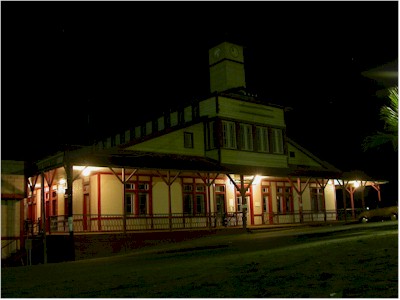 |
|
Former El Boleo office, now museum |
Santa Rosalia really was fascinating, with all the wooden houses and buildings so unlike any in Baja and all sorts of cool mining paraphernalia. Some of the old buildings, such as the above mentioned Hotel Frances and El Boleo offices were beautifully restored. A terrific museum is housed in the former El Boleo offices overlooking the rusting smelting plant and harbor. A number of old steam engines and donkeys are placed throughout the town. Overall, the historical society has done a excellent job preserving the town's past and we really enjoyed exploring it. The downtown streets were quite lively with all sorts of interesting shops and restaurants, internet cafes, the famous Eiffel church and of course the delicious French bakery (delicious tortillas of course!) and best of all streets full of friendly people.
We did not enjoy, however, the Port Captain check-in/out dance we had to perform here, for the first time since La Paz. Luckily Santa Rosalia is a small town and the walking was pleasant, but the process is still exasperating, to say the least, not to mention expensive. We first went to the Port Captain's office about half mile south of the marina, where we were told we needed to go to Immigration first, back by the marina. On the way to the Port Captain's we had to stop by the API office to pay some sort of fee ($60 pesos or $6US). Then we had to return to the Port Captain's office to show our ship's papers and crew lists, followed by a trip to the Banamex bank over in downtown Santa Rosalia (past the marina again) to pay our standard $320 peso ($32US) check-in/out fee. Finally we returned to the Port Captain's office to show our bank receipt and were presented with our papers, all beautifully stamped with colorful insignias. We were clever this time and did the check-in/out all at the same time, but were supposed to leave then in 48 hours...we figured we'd leave somewhere about that time.
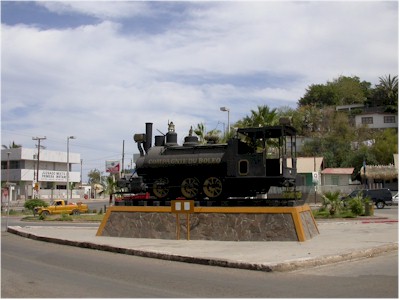 |
|
El Boleo steam engine |
In Santa Rosalia we celebrated our third wedding anniversary with a dinner out at Tercos Pollitos, a wonderful restaurant displaying old photos of the town. Our favorite was the one of the huge old sailing ships anchored in the harbor. Tercos Pollitos has great food -- huge combo platters with tacos, tamales and chile rellanos for only about $4.50US.
On the dock at Marina Santa Rosalia we got to talking to a nearby cruiser who told us he was trucking his boat back to the states as well. We asked when his trucking date was, just out of curiosity, and he told us June 2nd. That is curious, we said, as that is our trucking date too. We thought, hopefully, that maybe they had got another truck and trailer and were hauling two boats a day. But we knew that probably wasn't likely and had better get moving over to San Carlos, 75 miles across the Sea of Cortez to see what had happened to our schedule.
So before sunrise a few mornings later, we left our comfortable berth at Marina San Carlos to make our final sail across the sea to San Carlos. The forecast was for light northerly winds (wouldn't you know -- the one time the north winds would have been on our beam and we didn't mind blowing a bit!). Happily, we were able to sail the first 30 or so miles across the sea in about 10-15 knots of wind. It was great being able to set the Monitor to steer one last time and just sit back and Pelican sail herself comfortable through the waves as she so loves.
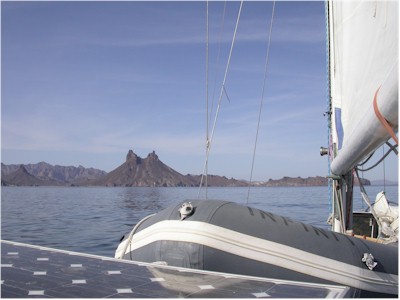 |
|
Tetas de Cabra of San Carlos |
About halfway across, we caught a 15 lb. dorado -- perfect for dinner, and a great finale to our fishing escapades in Mexico. Just after that, the wind died down completely and we were left bobbing around in a completely glassy sea. So, on went the motor for the last hot 40 miles.
We arrived at San Carlos at 1800 and anchored near our friends on Tillicum in the well protected harbor surrounded by tall sonoran desert mountains, with views of the Tetas de Cabra ("Goat Teat mountain" that looks exactly like that). We had almost a month to go before Pelican would be loaded on the truck (we hoped) but it was nice to have plenty of time to figure out how the rest of the crew was going to get back north again, plus explore the area a bit including the city of Guaymas a few kilometers south.
Although we were happy to have reached our final destination in Mexico safely, it was a bit of a melancholy time for us knowing that our year of cruising was nearly over. We are excited to be back home in the Northwest, with family and friends again who we've missed dearly the past year. But we will surely miss the life of leisure we've lead cruising down here in the sun and warm water, new and old friends in nearly every anchorage and of course exploring the fascinating country of Mexico with all her warm people.